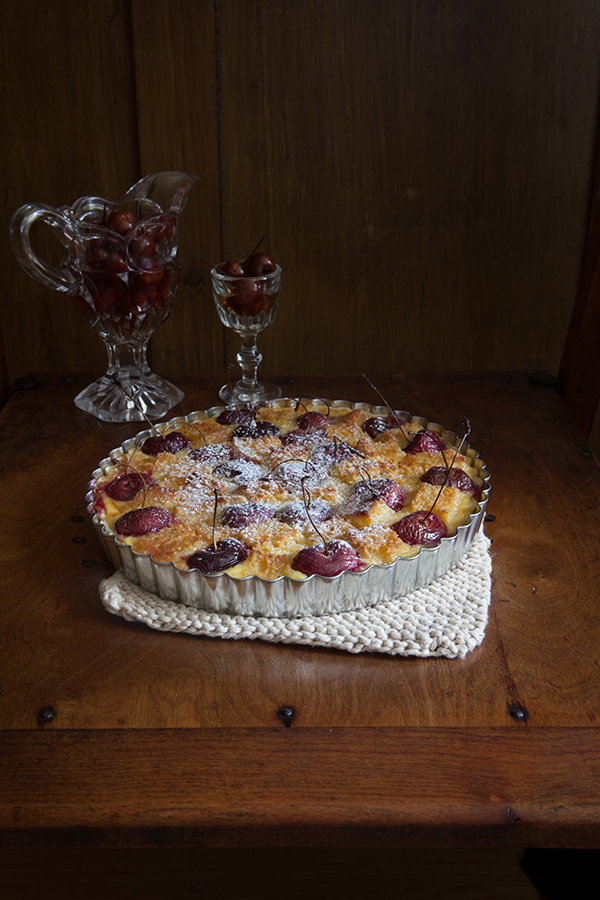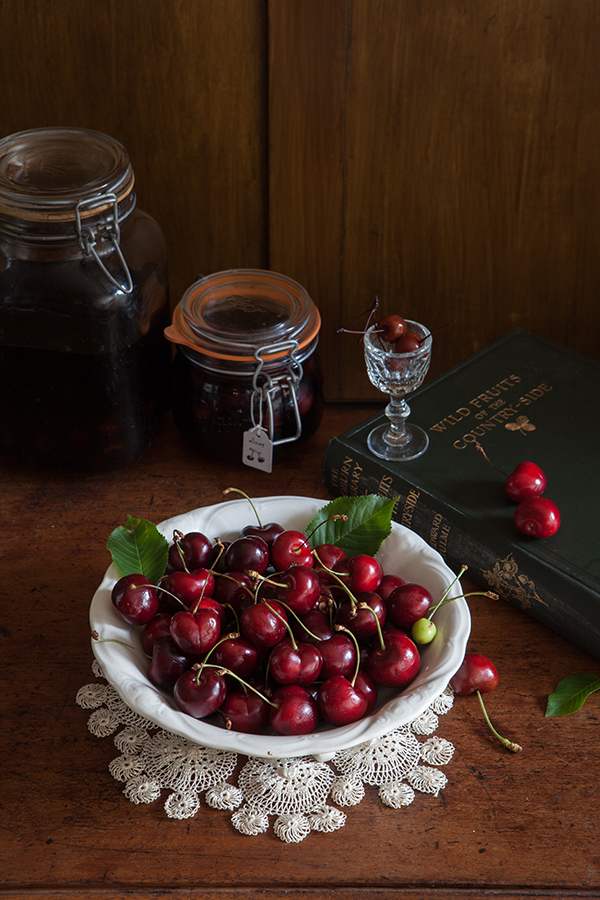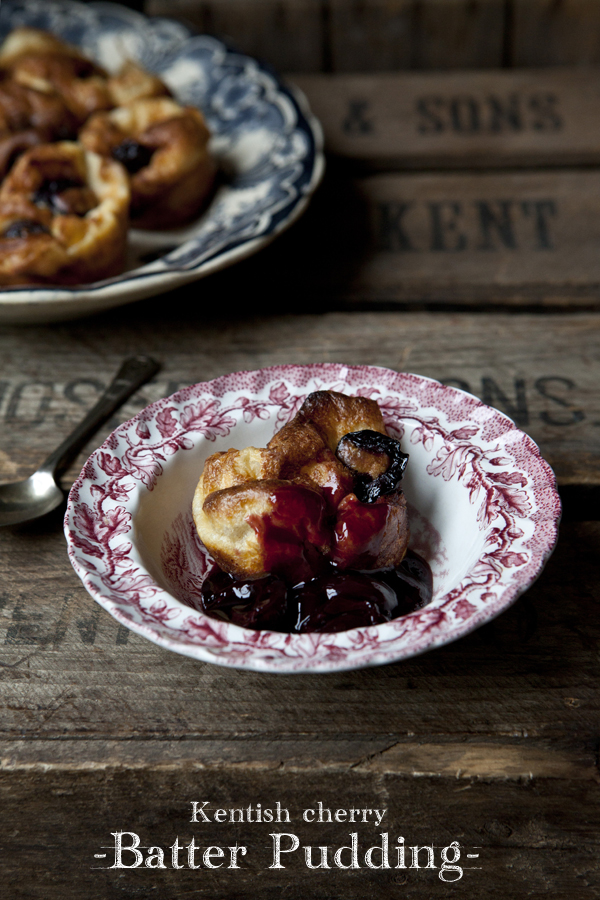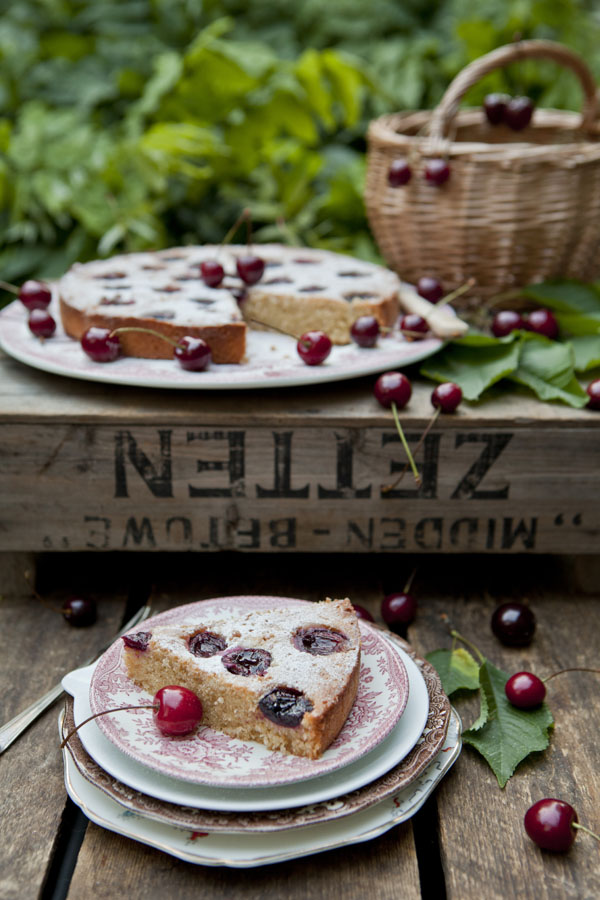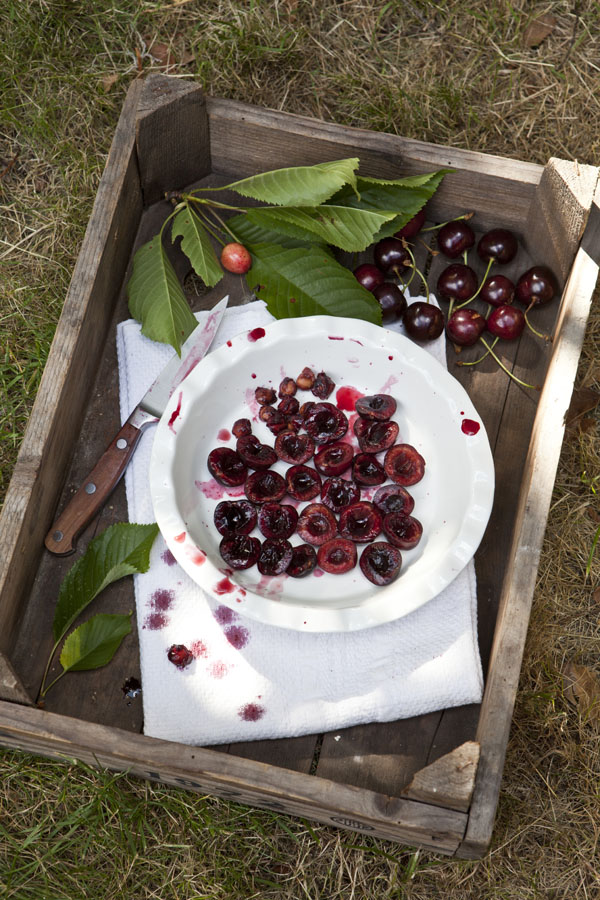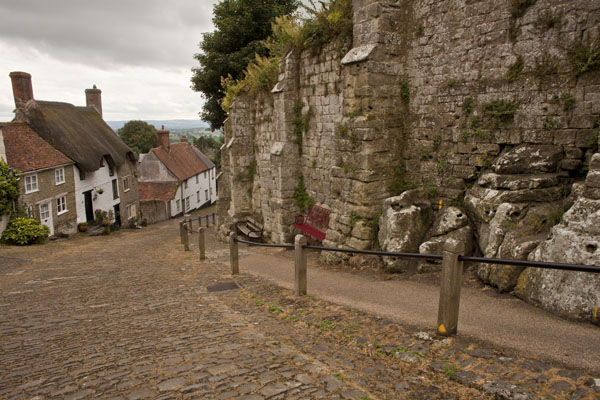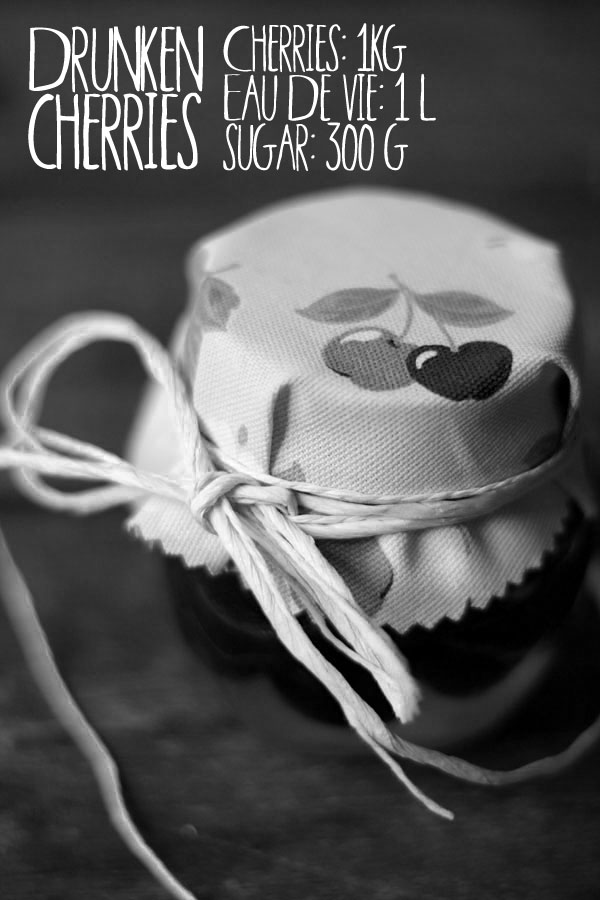 Preparing the cherry brandy or ‘Kriekenborrel’ as we called it in Belgium, is the first step towards Christmas and winter for me. On Christmas eve when I was a child, I was allowed one single drunken cherry in a small dainty glass as a treat. This is how memories are made, and how time and time again when Christmas comes, you need certain flavours to transport you back to the past. Nostalgia and Christmas go hand in hand. It is the one western tradition that is still going strong. People prepare things like this cherry brandy and plum pudding months in advance. The anticipation grows in the jars, and by every spoonful of brandy that is poured over the pudding every week.
Preparing the cherry brandy or ‘Kriekenborrel’ as we called it in Belgium, is the first step towards Christmas and winter for me. On Christmas eve when I was a child, I was allowed one single drunken cherry in a small dainty glass as a treat. This is how memories are made, and how time and time again when Christmas comes, you need certain flavours to transport you back to the past. Nostalgia and Christmas go hand in hand. It is the one western tradition that is still going strong. People prepare things like this cherry brandy and plum pudding months in advance. The anticipation grows in the jars, and by every spoonful of brandy that is poured over the pudding every week.
Preserving fruit in ‘Jenever’ which is almost identical to Gin, has been a custom in our parts for many decades. It was particularly popular in the 1950’s when my grandmother was young. Because my mother grew up with it, it was sentimental to her, which is why she taught me how to make it. I still have the last jar of cherries my mum and I drowned in Eau de Vie in 1998. It is quite special, because the jar holds memories as well as cherries. In my kitchen I have jars from 2006, 2010, 2011 and 2013. Some I give away, ladling the cherries and booze out into smaller jars to decorate with a ribbon and the date. They go to people I know will appreciate my precious preserve. Because I part with memories of making them and hope they will be cherished….
cherries
Cherry tart and prostitution
When I was a little girl my parents and I used to travel around Hungary in the summer. I can still remember the warm climate, and the little dresses I wore, many of which I have in a shoe box upstairs. What I also remember is the Bed and Breakfast, back then called ‘Zimmer frei’ in Hungary, which was run by an old couple. The woman looked a lot like my aunt and the man I can’t remember much. Their house was large for Hungary and by a main road, not far from a little restaurant by the river Danube where I always ate a very good omelette for supper.
Our time with the old couple was like staying with your grandparents, sure communication was complicated, they spoke a little German, so did my parents, and I as a four year old strangely enough spoke a good word of German too. They were loving people and love can be shown without the language barrier. Each day we entered our room, the old lady surprised us with a large stone bowl of the most plump cherries I have ever seen. As a child, and a picky eater, those cherries were some kind of heaven. Food I knew, and was so expensive at home that I could never really eat so many that my fingers would be stained in cherry juice.
And every day a bowl appeared, and every day we were greeted by the most loving smiles and gestures by these two wonderful people.
Two years after our last visit to the old couple’s Zimmer Frei we decided to do a detour and stay with them for a couple of nights. I requested it especially because I was eager to see my Hungarian grandparents as they had become to be for me. My parents too had never encountered such kindness and were eager to stay there again too.
So we drove to the rather large Hungarian house and as we parked the car I ran towards the door where the old lady – she must have been in her early seventies – was sitting in her chair.
But while I was running towards her the first thing I noticed was the anxious look in her eyes, and then the dress that she wore. As before she always wore granny clothes, now she was wearing a black embroidered dress with a deep decollete and very large earrings.
Anxious as she was, but really happy to see us, she told my parents that she would love it if we would stay but that she was no longer a Zimmer Frei since her husband had died the year before.
I wondered what the young girls were doing there if she wasn’t offering lodgings anymore, and somehow, while she was showing us to our room and I saw how the house had changed and lost all its granny appeal, I knew. I knew without without having the knowledge of years.
Heartbroken and realising that there might not be a bowl of cherries in our room each day, and hurt by the uncomfortable anxious look in my Hungarian grandma’s eyes we said we’d go for dinner and then come back to decide if we would stay.
The granny had tears in her eyes, and I felt like she was holding on to the summers and the bowls of cherries as much as I was doing. But those times were gone. The light had gone out in the rather large Hungarian house. It was replaced by sorrow, regret, and a need for survival.
So we ate an omelette at the restaurant by the river, and my parents gave me the choice on whether to stay at the granny’s house. Too young to understand what was happening at the house, but old enough to feel there was something wrong, I told them that I felt that it wasn’t right for us to stay there.
So we drove back to the granny’s house, and said our goodbyes, granny still trying to convince us we were so very welcome. But I was feeling so very sad. I could not understand what had happened and somehow I knew that by staying we would not only make her happy, we would also maker her very sad.
She had made her choice, and there would be no more bowls of cherries.
I hope she was at peace at the end of her life, so very long ago.
In her memory I have prepared this cherry tart, inspired by 18th century tarts, some of which you’ll find in my upcoming book. It’s a perfect tart to make when you have leftover sponge cake, that way you don’t need to bake a cake especially. The tart has a pleasant texture, though not like the tarts you are probably used to. Let me know if you’ve tried it!
x R
Cherry tart with curstard and sponge cake
What you need
Shortcrust pastry
- 180 g white flour
- 100g cold butter
- 20 g icing sugar
- tiny pinch salt
- 1 egg yolk
- 1 tbsp of cold water
Custard
- 250 ml cream
- 3 egg yolks
- a blade of mace
- a stick of cinnamon
- 1tbsp of raw cane sugar
Filling
- Sponge cake, preferably stale
- 2 tbsp of brandy (optional)
- a punnet of cherries
- 2 tbsp of unsalted butter – or bone marrow
- 22-24 sized pie pan or plate
Kentish cherry batter pudding
Batter puddings have been around for centuries. Originally they were named ‘dripping puddings’ because they were placed in trays underneath large spit-roasts to catch the dripping of the meat. In the 1747 book The Art of Cookery made Plain and Easy, Hannah Glasse renamed the dripping pudding to the now more generally known Yorkshire pudding.
‘Yorkies’ were provided to stretch the meat a little longer, soaked in gravy they are very child’s favourite and traditionally served as a filling dish before the main meat dish came to the table rather than accompanying it.
But batter puddings haven’t always been the perfect partner in crime to a good sunday roast, they have also been savored as a sweet treats as well. Mostly the rich puddings were just drizzled with a dusting of fine sugar but in the summer season and early autumn when there was a glut of fruit to use up, a sauce of cherries or plums would have been made to accompany the batter pudding.
Although there is no proof of age for the recipe of the Kentish cherry batter pudding, before the second world war there were about 40 000 acres of cherry orchards in Britain and most of them were situated in Kent. This does tell us that there were a lot of cherries about and not all of those cherries would have been exported to other parts of the country. Sadly only 90 percent of these orchards remain today but luckily the last few years Kentish cherries have seen a revival with new orchards being planted.
Cherry trees are kept much shorter now, making it easier to harvest. In the old days, mostly women would pick the cherries standing on high ladders with wicker baskets tied to their waists.
I reaslise this recipe comes at the very end of the cherry season, but you can also use the cherry brandy you have in your cupboard if you made some last year. Or like me if you made some every year for the past 5 years. I age them in years, only just opened up my 10 year old, after which I didn’t make any for 5 years. Some people who I like very much have received a tiny jar of those cherries so if you have, open the jar wisely.
This post also comes at the very end of the season because I have been so very busy, I already mentioned in my last my last post I’m writing a book but I’m also taking on an extra course in culinary school.
But on to the Kentish cherry batter pudding
What do you need
For the batter – makes 12 muffing size puddings
- 120 g plain or white spelt flour
- 2 large free-range eggs
- 240 ml full-fat milk
- a pinch of sea salt
- rapeseed, sunflower or lard for baking
For the cherry sauce
- 300g cherries
- 150 ml unsweetened apple juice or water
- 40 g raw cane sugar
- 2 teaspoons of cornstarch if you wish to thicken the sauce
Method
- Preheat your oven to 200° C
- To make the batter, sift the flour – very important here – and add the eggs, add the milk slowly while whisking the batter to create a mixture resembling a slightly thicker pancake batter.
- To make the cherry sauce, remove the stones from the cherries by halving them or use a fancy tool to get the stone out. Place in a small pan and bring to a simmer with the water or apple juice.
- Add the sugar and let it dissolve, simmer until you get a dark colored sauce. I like not to cook it too long so the cherries aren’t reduced to jam.
- If you like a thicker sauce add the cornstarch to packet instructions and when done put aside
- Place a generously greased muffin tin in the preheated oven.
- When the oil is hot, be quick as it should stay hot. Get the tin out of the oven safely, don’t spill the hot grease!
- Scoop batter into each muffing shape and then add a cherry or two from your braised cherries, or from your cherry brandy.
- Place into the oven and don’t touch the oven door until the batter puddings have risen and are golden brown, this should be about 25-30 minutes.
- Serve with some of the braised cherries, a spoonful of clotted cream or strained yoghurt (Greek style)
Tip: Just use leftover Yorkshire puds if you have them, and also these puds freeze well!
I’ll share with you which beer I would have with this pudding, to stay in the cherry mood: a traditional Belgian sour cherry beer, not a sweet one like the more commercial brands. A sour one which has a hint of the kernels and vanilla like a Liefmans Kriek, or a provision beer like a Liefmans Goudenband. For more international beers I think a sweet ans mooth porter would do the trick. Or, if you have cherry brandy, a little glass of cherry brandy of course!
Enjoy!
You might also like
Cherry and almond cake
Cherry brandy
Cherry and almond cake and a walk on Gold Hill in Dorset
As the weather suddenly changed from gloriously sunny to dreadfully grey again, I ventured out to beautiful yet misty Dorset to be a judge on the Great Taste Awards.
After seven hours on several trains I finally arrived in Shaftesbury, one of the highest and oldest towns in England. Shaftesbury, also known as Scaepterbyrg in the Domesday book was either built or rebuilt by Alfred the Great in the 9th century when he also founded the abbey where his daughter Ethelgiva would be the abbess. Although a Saxon settlement, there is reason to believe that a much older Celtic village named Caer Palladur used to exist on this hilltop.
I walked up and down Gold Hill three times and sat on the cobbled street at the top of the hill to watch the evening spread it’s cloak over the valley. After a walk I ended my day with a much needed pint of Chocolate Stout at a local pub and a plate of excellent Devon crab – with Hovis bread of course, as you do when in Shaftesbury. The town and especially Gold Hill has become famous for the evocative Hovis advertisement film in the seventies. The film was directed by Riddley Scott, whom you might know from films like Gladiator and featured a small lad pushing a bike with a basket laden with a loaves of bread up the steep cobbled street of Gold Hill on the tunes of Dvorak’s ‘New World’ Symphony. The advert has been voted Britain’s most popular advertisement of all time and shows the power of a good advertising campaign. It’s a deceiving plot to convince the consumer that Hovis bread is something more artisan than just a factory made bread. It feeds on nostalgia, showing images of times gone by, suggesting the bread is still being made by the traditional method. It is not. It is made by the fast ‘no-time dough’ Chorleywood method using not only wheat flour but also a larger amount of yeast, emulsifier, stabiliser and Soya flour. Things that are hardly traditional.
This brings me back to the Great Taste awards and how important the Guild of Fine Food is in supporting artisan and ‘real food’ producers. We’re turning back towards foods that are once more traditionally made with the best possible ingredients out there. Pasture fed beef is now a regular term as well as rare breed pork and raw milk yoghurt. We want quality for our pennies again, and we want to make a difference when we do our food shopping.
After my ponder gazing down over Gold Hill I decided an early night is what was needed as the next morning some serious judging had to be done. Not only is winning a Great Taste Award for your product an excellent way of promoting it, it’s also an unique opportunity to receive feedback about that product from the ‘crème de la crème’ of the British and Irish food scene. The panel of experts is perfectly balanced and consisting of food buyers for the leading speciality stores, seasoned food writers, critics, chefs and other people who have earned their mark in food.
Every grade we gave was weighed up and discussed, these decisions have not been taken lightly as so much depends on it for the producer. In the afternoon it was up to a selection of the judges to choose the overall winner from the 15 products that were chosen to receive the 3 star rating. I can’t be sure which of the products won the overall winner of the awards, I have my fair idea as one of the products left me silent and wanting for more… We will have to wait until september when all the winnings are announced.
I feel truly privileged to have been a part of this and to taste so much beautiful food.

So here I give you a slice of the cake I took with me on my long travel to Dorset this week. A super easy gluten-free, low GI, super delicious and nourishing Cherry and Almond cake.
While other years the yield of my tree was about five cherries, this year it must have been twenty. I had my eye on them as the birds had too, and I was set on picking the little red jewels before the birds would steal them. Although I do feel a bit guilty for taking this delicious cherry treat away from Mr and Ms Blackbird, the family Great tit and the little Wrens, this would be the first year I would actually get to enjoy my own crop.
At first I was thinking of preserving the cherries by making my cherry brandy, but then I suddenly craved a cake with almonds and thought the cherries would make a lovely addition to the bake.
I really was too hot to turn on the oven to be honest, but when a girl wants cake you can’t argue with her. So I baked.
To get as much out of the oven temperature as possible I also added a jar of prunes to the oven, I like to do that because then you are using your oven for more than just your cake and end up with a lovely slow cooked prune puree that works like magic as a filling in a prune tart like this one here.
What do you need
- 200 g good quality unsalted butter soft, not runny
- 100 g sugar
- 3 organic eggs
- 50 g buckwheat meal or another gluten-free flour
- 125 g almond meal made of blanched almonds
- cherries, a handful, pitted and halved
Method
- Prepare a 22 cm round cake tin – spring form is best -with greaseproof paper and set aside
- Preheat your oven to 160° C
- Cream the soft butter and sugar together in a mixing bowl and use an electric mixer to beat the mixture until light and fluffy
- Add the eggs one by one, beating well
- Add the almond meal and the other chosen gluten-free flour bit by bit and combine well
- Transfer the dough into the prepared cake tin, press down the halved cherries into the dough and put in the preheated oven for 60 minutes or until golden.
Tip: Why not use the cherries from last years Cherry brandy ?
You might also like
Strawberry Spelt Shortcake
Chocolate beetroot and walnut cake
Cherry brandy
Drunken cherries – make your own cherry brandy
Preserving cherries for later, for generations to come.
“My top way of eating cherries is a bowl of cherries. If good, they need no adornment, other than perhaps a glass of pink champagne.”
Fergus Henderson.
Before the second world war there were about 40 000 acres of cherry orchards in Britain. These were mainly in Kent, Worcestershire and Herefordshire.
The past 50 years however 90 % of these cherry orchards have disappeared.
The labour was very intensive as the trees were very high, too high to cover the crop from the birds. I were mostly women who harvested the cherries on high ladders with baskets tied to their waists.
To tackle this problem nowadays and to revive cherry growing, dwarf plants are planted to replace the towering trees. The dwarf trees are covered with netting so the birds can’t steal the crop and the orchard has a maximum yield.
The people from Food Lovers Britain have started ‘CherryAid’, a campaign to point out to the supermarkets and consumers that the British cherry needs our attention and preservation. Since the campaign started most of Britain’s biggest supermarkets like M&S and Tesco are selling British cherries and Waitrose has stated that imported cherries will be phased out completely for the five week the British cherry season.
So it’s fair to say, British cherries are on their way of being saved for future generations.
Britain however is not the only country in danger of loosing their native fruit, in Belgium you can’t even get Belgian cherries in the supermarket. You find them rarely at the market. A lot of cherry growers in Belgium leave their crop rot on the trees because it’s too expensive to pick them for the price they will get for them. Such a shame that the most famous ‘Schaerbeekse cherry’ has been lost for ever, this was the variety used for the typical Belgian cherry beer. Instead of finding another Belgian cherry, most of the breweries choose to import the cherries from Poland. Only a small number of cherries used for the beer today are Belgian.
Most of you will try and buy ‘local’ or British cherries, I’m sure.
I love how the cherry season transforms the roads of Kent with cherry
signs and little stalls packed with punnets of cherries. The sellers
sitting there, usually seeking shelter from wind and rain under a bright
umbrella, reading a book.
Below some interesting links to explore:
Brogdale farm has an annual Cherry festival celebrating the British cherry and
Food Lovers Britain – ‘CherryAid’ a campaign to put British cherries back on the map.
Great British Food Revival Cherries and Walnuts
Rent a cherry tree
Cherries come in two types: sweet and sour. My mum and I used to make this cherry brandy and the recipe is handed down by my grandmother. For cherry brandy it’s better to use the sour variety however you can use the sweet ones and slightly decrease the sugar you use. Or not, if you like it very sweet!
So what about you? What do you like to brew?
What do you need
cherries: 1kg
Eau de vie or Vodka: 1liter
sugar: 300 g
sterilised jars
Method
• rinse the cherries well
• cut of the stalks leaving 1cm still on the cherry, that way the brandy will keep longer as
the cherries stay nice and firm.
• layer the cherries with the sugar
• pour over the alcohol and close the jar
• put in a dark place at room temperature and shake every day for a week
• forget about the cherries until christmas or thanksgiving!
I have jars that date back to 1999, these cherries are very very strong!
Enjoy in a little glass or why not with a scoop of ice cream…
You might also like
Strawberry and Pimm’s granita drink
Blaeberry pie
Please leave a comment, I love reading them!

